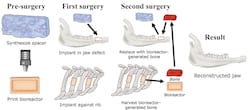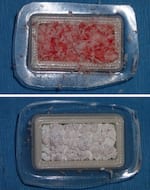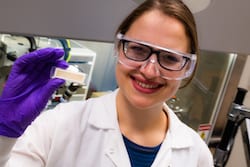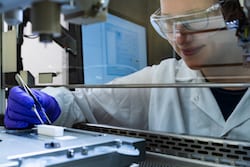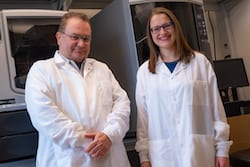NEWS RELEASE
Editor’s note: Links to high-resolution images for download appear at the end of this release.
David Ruth
713-348-6327
david@rice.edu
Mike Williams
713-348-6728
mikewilliams@rice.edu
Grow a better jawbone in your ribs
Rice U., UTHealth advance craniofacial surgery with 3D implants made inside the patient
HOUSTON – (March 18, 2019) – The jawbone is not typically connected to the rib bone, but it might be in an emergency.
Rice University bioengineers and their colleagues have developed a technique to grow live bone to repair craniofacial injuries by attaching a 3D-printed bioreactor — basically, a mold — to a rib. Stem cells and blood vessels from the rib infiltrate scaffold material in the mold and replace it with natural bone custom-fit to the patient.

Researchers at Rice University and the University of Texas Health Science Center at Houston develop a technique to grow custom-fit bone implants to repair jawbone injuries from a patient’s own rib. Illustration courtesy of the Mikos Research Group
Researchers at Rice, the University of Texas Health Science Center at Houston (UTHealth) and Baylor College of Medicine led the study, and the results appear in the Proceedings of the National Academy of Sciences.
Led by bioengineer Antonios Mikos, a pioneer in the field of tissue engineering, the researchers combined technologies they have developed during a decadelong program funded by the Armed Forces Institute of Regenerative Medicine. The goal is to advance craniofacial reconstruction by taking advantage of the body’s natural healing powers.
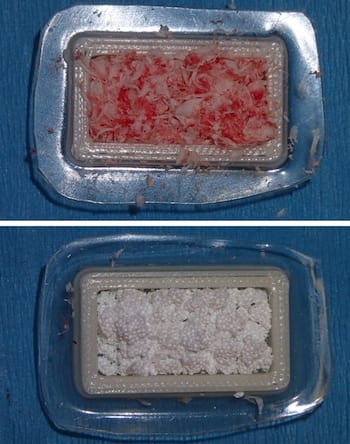
3D-printed bioreactors filled with autologous bone (top) or a synthetic graft (bottom) are key components of a new technique to grow custom-fit bone implants to repair jawbone injuries from a patient’s own rib. Courtesy of the Mikos Research Group
The technique is being developed to replace current reconstruction techniques that use bone graft tissues harvested from different areas in a patient, such as the lower leg, hip and shoulder.
“A major innovation of this work is leveraging a 3D-printed bioreactor to form bone grown in another part of the body while we prime the defect to accept the newly generated tissue,” said Mikos, the Louis Calder Professor of Bioengineering and Chemical and Biomolecular Engineering at Rice and a member of the National Academy of Engineering and National Academy of Medicine.
“Earlier studies established a technique for creating bone grafts with or without their own blood supply from real bone implanted into the chest cavity,” said co-author Mark Wong, a professor, chair and program director of the Department of Oral and Maxillofacial Surgery with the School of Dentistry at UTHealth. “This study demonstrated that we could create viable bone grafts from artificial bone substitute materials.
“The significant advantage of this approach is that you do not need to harvest a patient’s own bone to make a bone graft, but that other non-autogenous sources can be used,” he said.
To prove their concept, the researchers made a rectangular defect in the mandibles of sheep. They created a template for 3D printing and printed an implantable mold and a spacer, both made of PMMA, also known as bone cement. The goal of the spacer is to promote healing and prevent scar tissue from filling the defect site.
They removed enough bone from the animal model’s rib to expose the periosteum, which served as a source of stem cells and vasculature to seed scaffold material inside the mold. Test groups included crushed rib bone or synthetic calcium phosphate materials to make the biocompatible scaffold.

Gerry Koons, an M.D./Ph.D. student at Rice University and Baylor College of Medicine, holds a 3D-printed bioreactor used to grow new bone for an implant inside the patient’s own body. Photo by Jeff Fitlow
The mold, with the rib side open to create a tight interface, stayed in place for nine weeks before removal and transfer to the site of the defect, replacing the spacer. In the animal models, the new bone knitted to the old and soft tissue grew around and covered the site.
“We chose to use ribs because they’re easily accessed and a rich source of stem cells and vessels, which infiltrate the scaffold and grow into new bone tissue that matches the patient,” Mikos said. “There’s no need for exogenous growth factors or cells that would complicate the regulatory approval process and translation to clinical applications.”
Ribs offer another advantage. “We can potentially grow new bone on multiple ribs at the same time,” said co-author Gerry Koons, an M.D./Ph.D. student at Rice and Baylor currently working in Mikos’ lab.
Using PMMA for the mold and spacer was a simple decision, Mikos said, as it has been regulated as a medical device for biological applications for decades. In World War II, when PMMA was used as a windshield for fighter planes, doctors noticed that shards embedded in injured pilots did not cause inflammation and thus considered it benign.
While the study’s initial goal is to improve the treatment of battlefield injuries, the big picture includes civilian surgeries as well.
“We’re delighted to bring together this diversely talented team and deliver promising outcomes to the future healing of the wounded warrior and other patients in need of advanced treatments for the jaw and face,” Mikos said.
Alexander Tatara, a Rice alumnus and also part of the Rice-Baylor M.D./Ph.D. program, is lead author of the paper. Co-authors include former and current Baylor/Rice M.D./Ph.D. students Emma Watson, Sarita Shah and Brandon Smith; Rice graduate student Trenton Piepergerdes; Associate Professors Jonathan Shum and Issa Hanna, division director and Professor Nagi Demian, and Assistant Professor James Melville, all from the Department of Oral and Maxillofacial Surgery; UTHealth otorhinolaryngologist Associate Professor Tang Ho; Anthony Ratcliffe of Synthasome, Inc., San Diego; and Associate Professor Jeroen van den Beucken and Professor John Janson of Radboud University Medical Center, Netherlands. Wong also holds the Dr. Bernard and Gloria P. Katz Chair in Oral and Maxillofacial Surgery at UTHealth.
Additional support for the research came from the National Institutes of Health, the Osteo Science Foundation, the Barrow Scholars Program, and the Robert and Janice McNair Foundation.
-30-
Read the abstract at www.pnas.org/cgi/doi/10.1073/pnas.1819246116.
Follow Rice News and Media Relations via Twitter @RiceUNews.
Related materials:
Mikos Research Group: http://www.ruf.rice.edu/~mikosgrp/
Mark Wong bio: https://dentistry.uth.edu/directory/profile.htm?id=d6d0f42f-e4d1-4a47-a5e3-ea705237b52e
Rice Department of Bioengineering: https://bioengineering.rice.edu
George R. Brown School of Engineering: https://engineering.rice.edu
Images for download:
https://news2.rice.edu/files/2019/03/0318_-JAW-1-web-2847vvl.jpg
Researchers at Rice University and the University of Texas Health Science Center at Houston develop a technique to grow custom-fit bone implants to repair jawbone injuries from a patient’s own rib. (Credit: Illustration courtesy of the Mikos Research Group/Rice University)
https://news2.rice.edu/files/2019/03/0318_-JAW-2-web-2o2oova.jpg
3D-printed bioreactors filled with autologous bone (top) or a synthetic graft (bottom) are key components of a new technique to grow custom-fit bone implants to repair jawbone injuries from a patient’s own rib. The technique was created at Rice University and the University of Texas Health Science Center at Houston. (Credit: Mikos Research Group/Rice University)
https://news2.rice.edu/files/2019/03/0318_-JAW-3-web-2it665o.jpg
Gerry Koons, an M.D./Ph.D. student at Rice University and Baylor College of Medicine, holds a 3D-printed bioreactor used to grow new bone for an implant inside the patient’s own body. (Credit: Jeff Fitlow/Rice University)
https://news2.rice.edu/files/2019/03/0318_-JAW-4-web-1t8wxo7.jpg
Gerry Koons, an M.D./Ph.D. student at Rice University and Baylor College of Medicine, prepares a 3D-printed bioreactor for tests. The lab developed a method to use bioreactors to grow new custom-fit bone from a patient’s rib for implant to the jaw. (Credit: Jeff Fitlow/Rice University)
https://news2.rice.edu/files/2019/03/0318_-JAW-5-web-1wd3gai.jpg
Rice University bioengineer Antonios Mikos and graduate student Gerry Koons helped develop a project to grow custom bone implants as part of a decadelong program funded by the Armed Forces Institute of Regenerative Medicine. The goal is to advance craniofacial reconstruction by taking advantage of the body’s natural healing powers. (Credit: Jeff Fitlow/Rice University)
Located on a 300-acre forested campus in Houston, Rice University is consistently ranked among the nation’s top 20 universities by U.S. News & World Report. Rice has highly respected schools of Architecture, Business, Continuing Studies, Engineering, Humanities, Music, Natural Sciences and Social Sciences and is home to the Baker Institute for Public Policy. With 3,962 undergraduates and 3,027 graduate students, Rice’s undergraduate student-to-faculty ratio is just under 6-to-1. Its residential college system builds close-knit communities and lifelong friendships, just one reason why Rice is ranked No. 1 for lots of race/class interaction and No. 2 for quality of life by the Princeton Review. Rice is also rated as a best value among private universities by Kiplinger’s Personal Finance.

